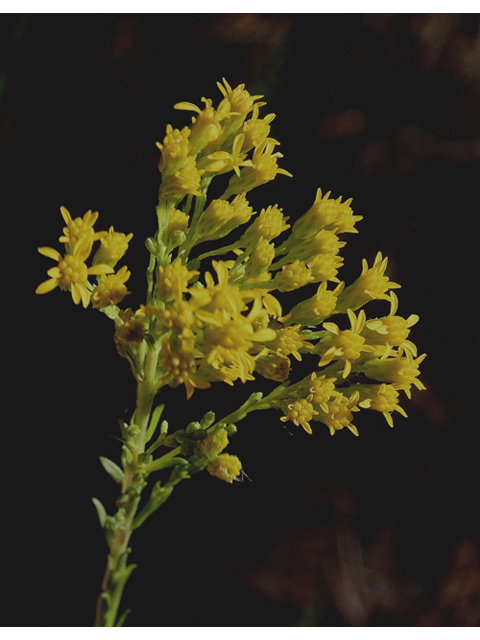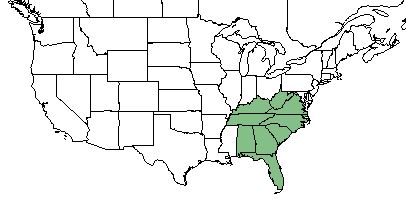Difference between revisions of "Solidago gracillima"
(→Ecology) |
HaleighJoM (talk | contribs) (→Ecology) |
||
| Line 33: | Line 33: | ||
Associated species: ''S. odora, S. arguta, Pityopsis aspera, Liatris gracilis, Calamintha dentata'', and ''Symphyotrichum''.<ref name="FSU"/> | Associated species: ''S. odora, S. arguta, Pityopsis aspera, Liatris gracilis, Calamintha dentata'', and ''Symphyotrichum''.<ref name="FSU"/> | ||
| − | |||
===Phenology=== <!--Timing off flowering, fruiting, seed dispersal, and environmental triggers. Cite PanFlora website if appropriate: http://www.gilnelson.com/PanFlora/ --> | ===Phenology=== <!--Timing off flowering, fruiting, seed dispersal, and environmental triggers. Cite PanFlora website if appropriate: http://www.gilnelson.com/PanFlora/ --> | ||
''S. gracillima'' has been observed to flower August through November.<ref name="Weakley 2015"/><ref name="PanFlora">Nelson, G. PanFlora: Plant data for the eastern United States with emphasis on the Southeastern Coastal Plains, Florida, and the Florida Panhandle. www.gilnelson.com/PanFlora/ Accessed: 18 JAN 2018</ref> | ''S. gracillima'' has been observed to flower August through November.<ref name="Weakley 2015"/><ref name="PanFlora">Nelson, G. PanFlora: Plant data for the eastern United States with emphasis on the Southeastern Coastal Plains, Florida, and the Florida Panhandle. www.gilnelson.com/PanFlora/ Accessed: 18 JAN 2018</ref> | ||
<!--===Seed dispersal===--> | <!--===Seed dispersal===--> | ||
<!--===Seed bank and germination===--> | <!--===Seed bank and germination===--> | ||
| − | |||
===Fire ecology=== <!--Fire tolerance, fire dependence, adaptive fire responses--> | ===Fire ecology=== <!--Fire tolerance, fire dependence, adaptive fire responses--> | ||
Populations of ''Solidago gracillima'' have been known to persist through repeated annual burning.<ref>Platt, W.J., R. Carter, G. Nelson, W. Baker, S. Hermann, J. Kane, L. Anderson, M. Smith, K. Robertson. 2021. Unpublished species list of Wade Tract old-growth longleaf pine savanna, Thomasville, Georgia.</ref> | Populations of ''Solidago gracillima'' have been known to persist through repeated annual burning.<ref>Platt, W.J., R. Carter, G. Nelson, W. Baker, S. Hermann, J. Kane, L. Anderson, M. Smith, K. Robertson. 2021. Unpublished species list of Wade Tract old-growth longleaf pine savanna, Thomasville, Georgia.</ref> | ||
| − | <!--===Pollination and | + | <!--===Pollination===--> |
| − | <!--==Diseases and parasites==--> | + | <!--===Herbivory and toxicology===<!--Common herbivores, granivory, insect hosting, poisonous chemicals, allelopathy, etc--> |
| + | <!--===Diseases and parasites===--> | ||
==Conservation, cultivation, and restoration== | ==Conservation, cultivation, and restoration== | ||
Latest revision as of 17:33, 15 July 2022
| Solidago gracillima | |
|---|---|

| |
| Photo by RW Smith hosted at Wildflowers.org | |
| Scientific classification | |
| Kingdom: | Plantae |
| Division: | Magnoliophyta - Flowering plants |
| Class: | Magnoliopsida - Dicots |
| Order: | Asterales |
| Family: | Asteraceae |
| Genus: | Solidago |
| Species: | S. gracillima |
| Binomial name | |
| Solidago gracillima Torr. and A. Gray | |

| |
| Natural range of Solidago gracillima from USDA NRCS Plants Database. | |
Common Name(s): southern bog goldenrod; graceful goldenrod;[1] Virginia goldenrod[2]
Contents
Taxonomic Notes
Synonym(s): S. austrina Small; S. perlonga Fernald; S. flavovirens; S. stricta Aiton ssp. gracillima (Torrey & A. Gray) Semple
Description
Solidago gracillima is a dioecious perennial forb/herb.[2] It has large inflorescences that are very open and have few long branches and smaller compact inflorescence without elongated lower branches.[3]
Distribution
This species is found from east Virginia, south to the central Florida panhandle, westward to south Alabama, and inland to Kentucky.[1][2]
Ecology
Habitat
S. gracillima is found in wet pine savannas, pine-oak woodlands, pine forests, sandy furrows, turkey oak sand ridges, wooded bluffs along creeks, longleaf pine-wiregrass, pine flatwoods, and seepage bogs.[1][4] It is also found in disturbed areas like longleaf pine restoration sites.[4]
Associated species: S. odora, S. arguta, Pityopsis aspera, Liatris gracilis, Calamintha dentata, and Symphyotrichum.[4]
Phenology
S. gracillima has been observed to flower August through November.[1][5]
Fire ecology
Populations of Solidago gracillima have been known to persist through repeated annual burning.[6]
Conservation, cultivation, and restoration
Cultural use
Photo Gallery
References and notes
- ↑ 1.0 1.1 1.2 1.3 Weakley AS (2015) Flora of the Southern and Mid-Atlantic States. Chapel Hill, NC: University of North Carolina Herbarium.
- ↑ 2.0 2.1 2.2 USDA NRCS (2016) The PLANTS Database (http://plants.usda.gov, 118 January 2018). National Plant Data Team, Greensboro, NC 27401-4901 USA.
- ↑ Semple JC (2012) Typification of Solidago gracillma (Asteraceae: Astereae) and application of the name. Phytoneuron 107:1-10.
- ↑ 4.0 4.1 4.2 Florida State University Herbarium Database. URL: http://herbarium.bio.fsu.edu. Last accessed: June 2021. Collectors: Loran C. Anderson, R.K. Godfrey, and Annie Schmidt. States and counties: Florida: Gadsden, Leon, Liberty, and Wakulla. Georgia: Baker.
- ↑ Nelson, G. PanFlora: Plant data for the eastern United States with emphasis on the Southeastern Coastal Plains, Florida, and the Florida Panhandle. www.gilnelson.com/PanFlora/ Accessed: 18 JAN 2018
- ↑ Platt, W.J., R. Carter, G. Nelson, W. Baker, S. Hermann, J. Kane, L. Anderson, M. Smith, K. Robertson. 2021. Unpublished species list of Wade Tract old-growth longleaf pine savanna, Thomasville, Georgia.